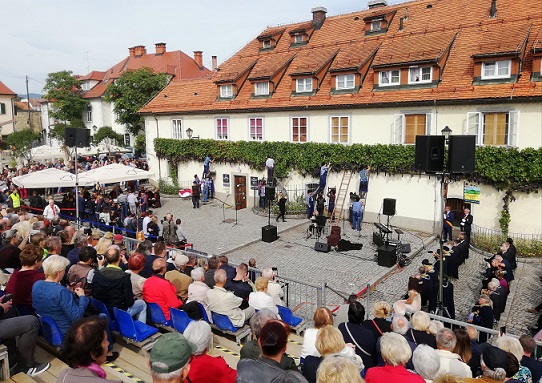
Hundreds of people came to watch. Many sat in a stand specially erected for the occasion. They came from near and far. The pickers dressed in historic costumes. There was a dancing display in the middle and speeches by two young women winemakers.
The harvest was also the climax of a two-week festival.
And all this fuss and attention was for ONE vine. One very special vine. A vine that has survived since the end of the Middle Ages. Growing against the city wall in Maribor, Slovenia’s second city, it survived the Ottoman invasion, bombings by Allied forces in World War II, several fires that destroyed nearby houses, and phylloxera.
When the parasite ravaged other vineyards in the region around 1870, this old vine’s roots were deep within the banks of the River Drava and out of bounds to the lice.
It’s biggest threat, though, was neglect in the 1960s and 1970s. Fortunately, the old vine was spotted by a group of experts from Slovenia’s Institute of Agriculture, which prevented the removal of the vine and the demolition of the adjacent dilapidated building. These experts, led by Tone Zafošnik, removed the dead parts and gave it a shot at a new life – as a tourist attraction.
The old building was turned into a wine museum and shop, and the old vine (‘Stara Trta’) now grows along its wall. The vine launched on the international stage in 2004 when it was entered in the Guinness Book of Records, as the world's oldest known grape-producing vine. Most commentators talk about it being more than 400 years old. The experts who examined it in 1972 said so – that means, by my reckoning, it’s nearly 450 years old.
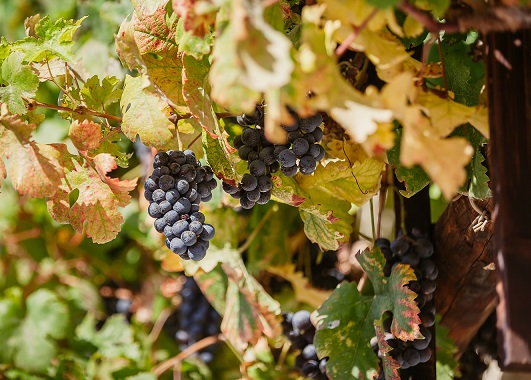
The variety?
The old and obscure variety is Žametovka (above - photo by Dejan Blut). More frequently found in the southeastern part of the country, from where it is believed to have originated, it is usually blended with white and red grapes (including Blaufrankisch) in a tart but popular traditional wine called Cviček.The old vine usually produces 35-55kg of grapes each year, but this year it went wild and delivered a record-breaking 107kg. The previous record of 91kg was set in 1991. The vine’s two offspring, left and right of the old vine, planted in 1987, yielded 97kg of grapes with a slightly lower sugar content – 65° Oechsle (16 Brix).
The reading from the old vine was 71° Oe (17.4 Brix). “This is a lower sugar level than we were used to, but completely understandable in terms of the amount of grapes,” explained the vine’s caretaker, Stane Kocutar.
'There will be no further tests of its endurance in the future'He went on to explain the lack of yield control this year: “Since last year’s grape harvest was relatively modest and the central part of the vine – above the trunk – was virtually cropless, I decided not to interfere with what the vine naturally offered as this year’s crop. Nothing was removed, the grapes matured nicely, the vine showed all vitality, but there will be no further tests of its endurance in the future.”
The harvest started with the Mayor of Marburg, Wieland Stötzl, cutting the first cluster to mark the 50th anniversary of the twinning of Maribor and German town Marburg. Representatives from Maribor’s other twin cities – Graz (Austria), Greenwich (United Kingdom), Kharkiv (Ukraine), Kraljevo (Serbia), Osijek (Croatia), Petange (Luxembourg) and Pueblo (USA) – came to watch, ensuring this harvest was an international affair.
The Mayor of Maribor and Master of the Old Vine, Saša Arsenovič, then confirmed that the grapes were ripe and ushered in the pickers, who came from the nearby village of Šompeter.
While they were picking the grapes in front of the Old Vine House in Lent, the oldest part of Maribor, there were talks about women in winemaking from Slovenian Wine Queen Meta Frangež (of Frangež Sparkling Wine House) and the Maribor Wine Queen, Ana Protner.
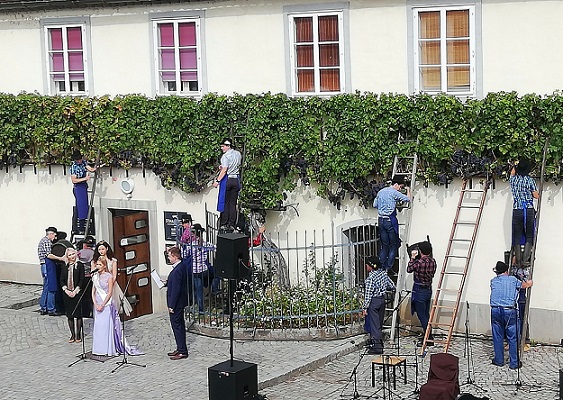
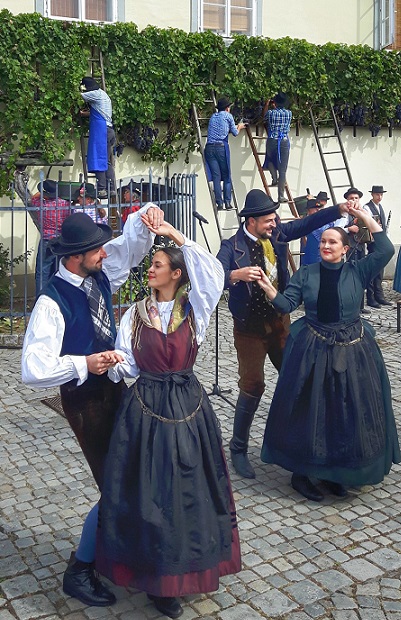
There was also music by accordionist Mateja Kožuh and local singer-songwriter Zoran Predin, and a dancing display by the folklore group Akademska folklorna skupina Študent (above - photo by Karmen Razlag).
The spectators at the 33th ceremonial grape harvest of the Old Vine also saw the grapes destemmed and crushed (main photo). The must went to the Meranovo Estate, a viticulture school since 1832.
The ceremony finished with the youngest picker squeezing a grape onto a vine shoot to thank it for its fruit.
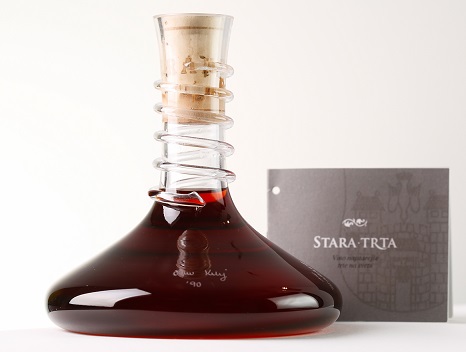
Fermentation usually takes about ten days. The light, low-alcohol, rose-coloured wine is put in 25cl bottles (above - photo by Domen Groegl) and given to dignitaries.
Stane said it “goes well with traditional Styrian dishes”.
The Old Vine Festival also features food and drinks stalls along the bank of the River Drava.
Other festivals associated with the Old Vine:
- St Martin’s Day (Martinovanje) on November 11;
- Setting up of the wind rattle in front of the Old Vine House (July 25, 2020);
- Pruning of the Old Vine (March 7, 2020).
A new wine museum
A new wine museum is being built in Maribor – at a cost of about €350,000. The museum, in a former cold room storage facility from the 17th century, will promote all of the Slovenia’s wine regions and feature a shop and wine tastings. Works are expected to be finished next year.However, many of the winegrowers Canopy spoke with at the festival want more attention paid to the city-owned vineyard on the hill behind Maribor. The vineyard, known as the Pyramid, has been criticised for being neglected.
The Maribor Wine Queen, Ana Protner, whose family make a highly regarded Riesling in the region, said: “We need to restore the Pyramid and its vineyard to its charm and reputation and to attract tourists. Much can be done with the Pyramid and its vines. Only will, money and interest are needed.”


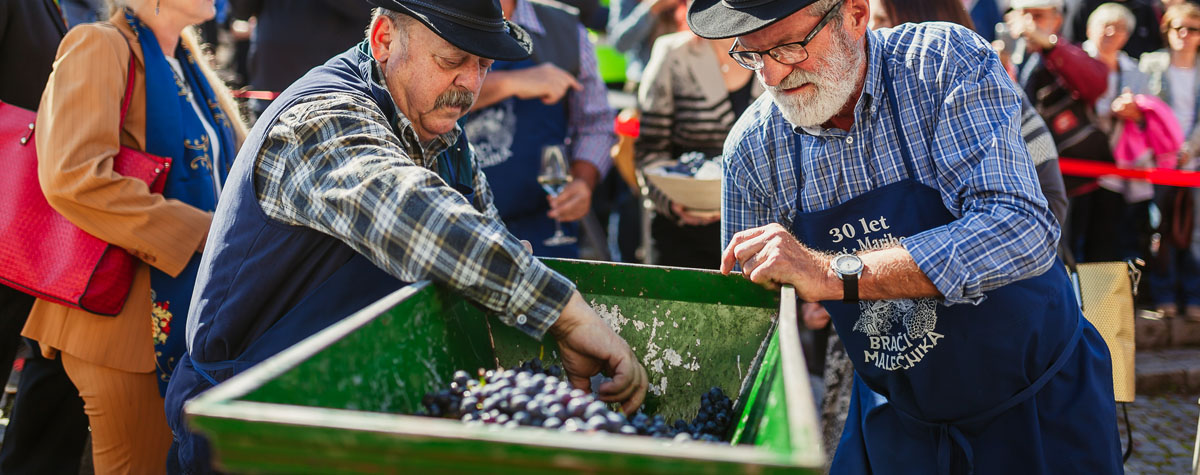










.png)






